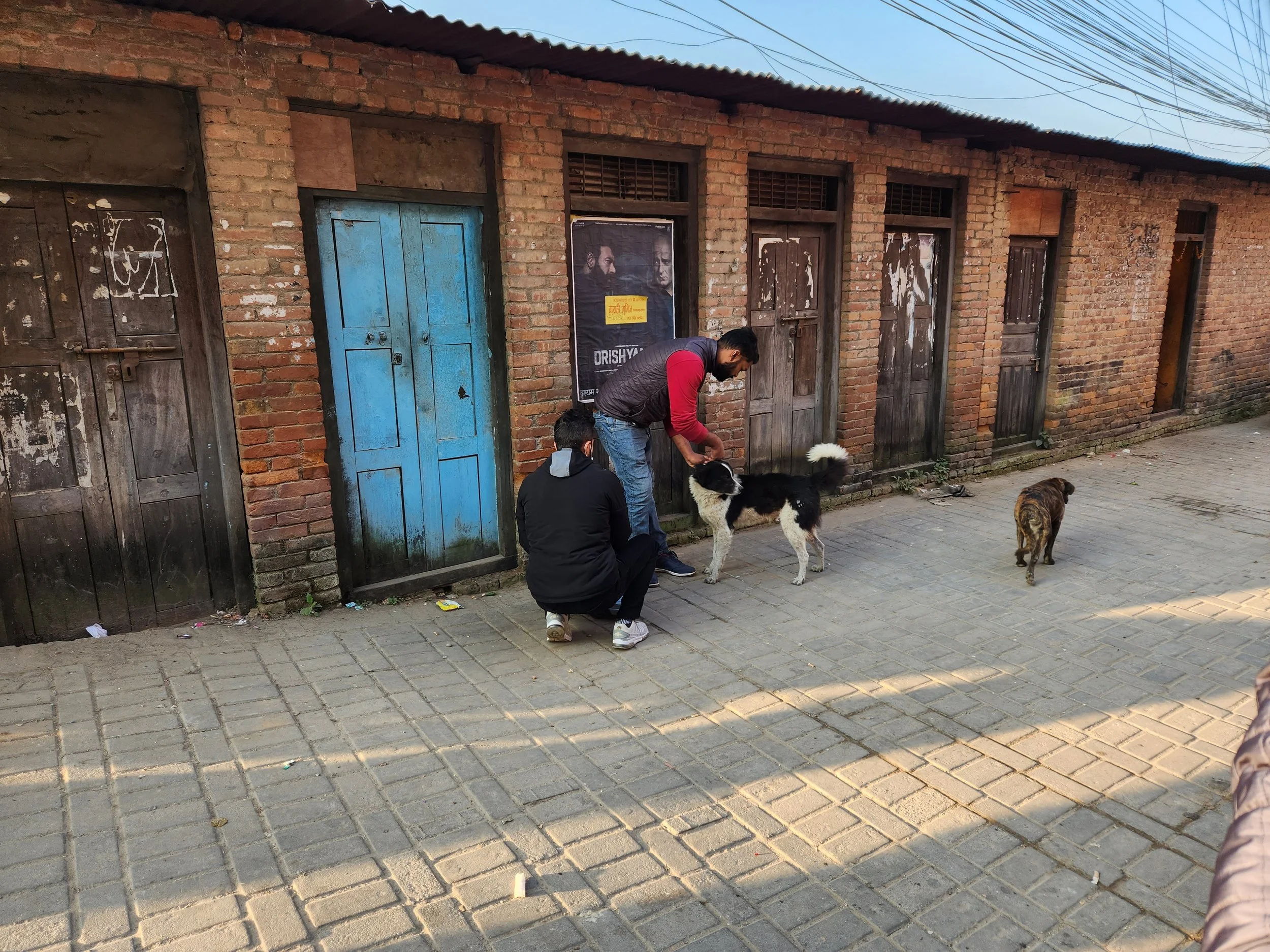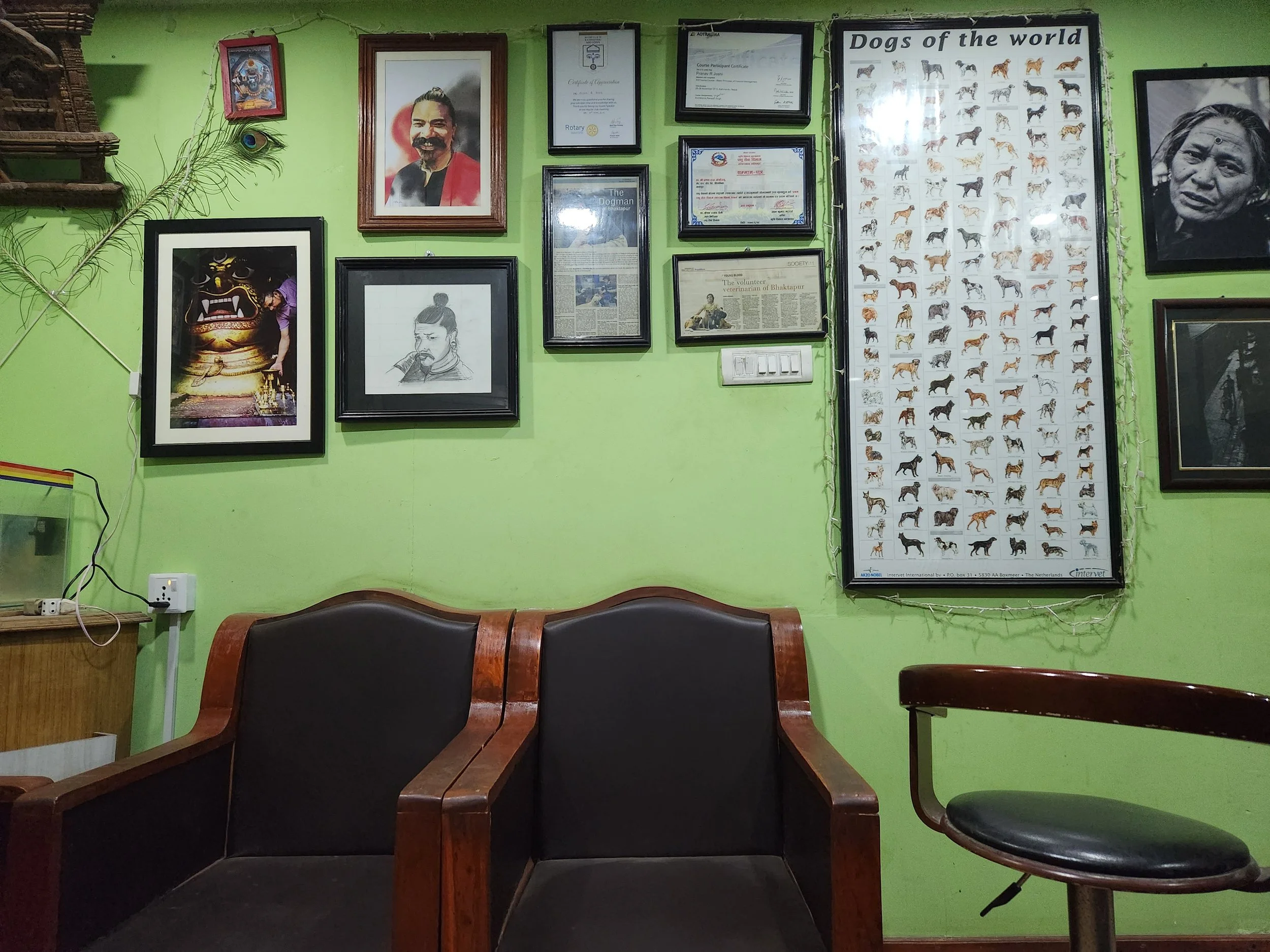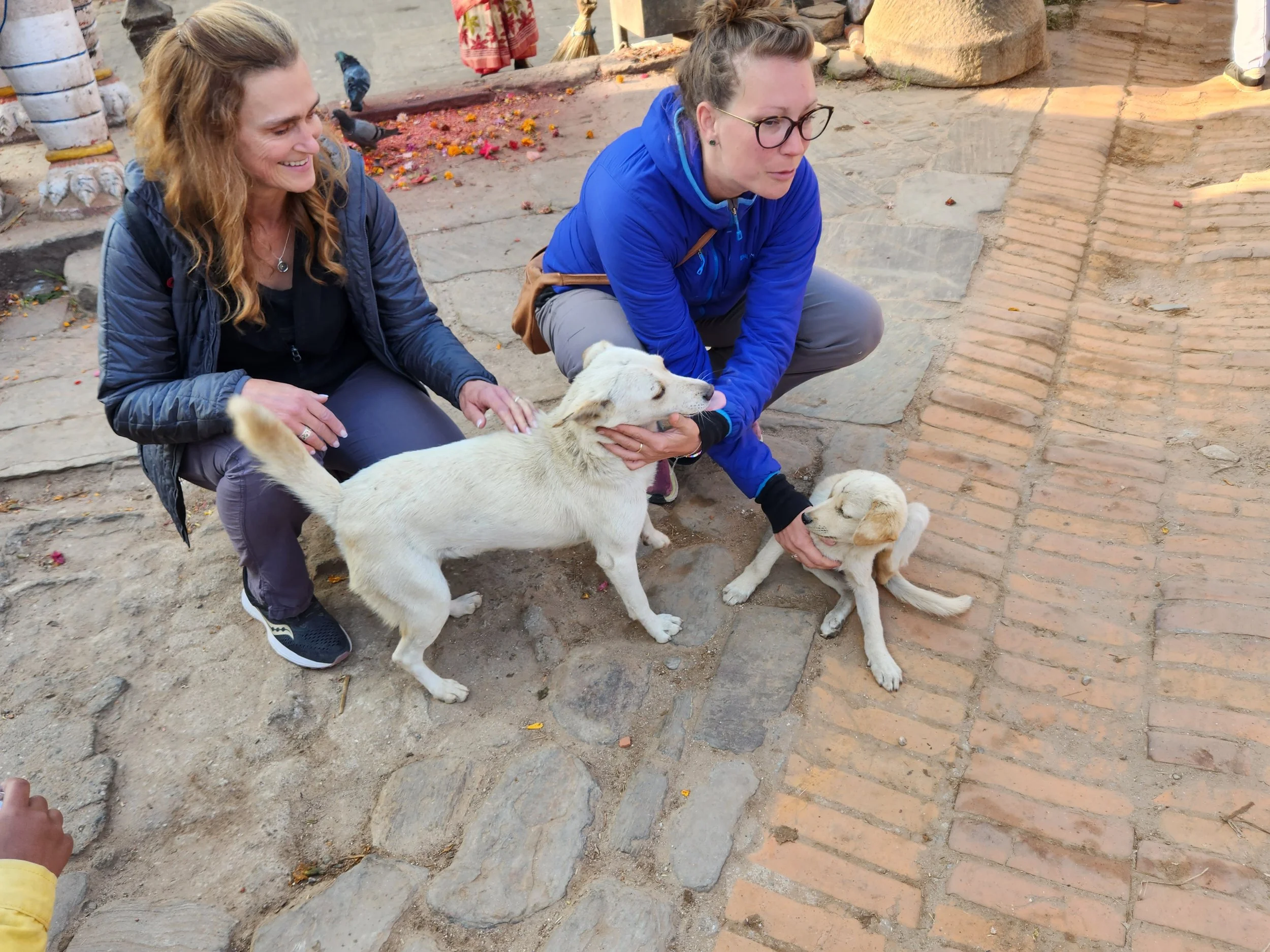Life on the Streets: Vet for Your Pet Protects Nepal's Street Dogs from Rabies
An inventive Nepali veterinarian and his team protect the community by vaccinating Bhaktapur street dogs for rabies.
Along the Araniko Highway, Bhaktapur street dogs walk up to Dr. Joshi like an old friend. Photo by Carrie Dow.
As we walked on a frontage road along the Araniko Highway in Bhaktapur, Nepal, Dr. Pranav Raj Joshi strolled ahead. Seeing a dog nearby, he slowly crouched down with his hand outstretched. The dog timidly walked over. As Dr. Joshi petted the brown stray along the neck, three other dogs wandered over, tails wagging. Behind him staff members from his clinic, Vet for Your Pet, quickly set into motion giving each dog a rabies vaccine in the scruff of their necks. Then Dr. Joshi stood up and the dogs walked away not even knowing that their lives had been saved.
The busy Araniko Highway in Bhaktapur, Nepal. The most common ailment of Nepal street dogs is getting hit by vehicles. Photo by Carrie Dow.
Dr. Joshi was demonstrating his street dog vaccination program for our travel group in Nepal. He is one of the country’s few internationally trained veterinarians and has two animal clinics, one in Nepal’s capital Kathmandu and his original clinic in his hometown of Bhaktapur, a historic city along the Hanumante River about 45 minutes from Kathmandu. He has dedicated his life to not only helping sick and injured animals, but his community.
Vet for Your Pet staff vaccinate street dogs for rabies. Photo by Carrie Dow.
“Our concept was to start a community hospital for animals. Most ambitious!” he said with a broad smile. “The Great Wall of China is the greatest structure – you can see it from the moon – but it was started with one brick at a time.”
Nepal is a country stretched between India and China on the edge of the Himalayan Mountains, the highest mountain range on Earth and home to Mount Everest. Bhaktapur is one of Nepal’s oldest cities with a history that goes back over a thousand years. Hindu and Buddhist traditions run deep. That includes the culture’s relationship with animals, especially dogs.
Nepali street dogs are nicknamed ‘cinnamon buns’ for how they sleep curled up on the street. Photo by Carrie Dow.
In Western cultures, dogs (and cats) are often taken into homes while street dogs are called strays – unwanted animals digging in trash cans for food. In many Eastern cultures, however, street dogs are the norm. They don’t belong to any one family, but instead become part of the larger community and form their own packs living their entire lives within a few city blocks. The people in those neighborhoods look after the dogs. As we walked around the city, I spotted bowls of water and rice and woven mats topped with crackers for dogs in front of buildings. At night the dogs curl up in those same spots. If they get sick or injured (getting hit by vehicles is the most common), residents take them to Dr. Joshi’s clinic for help. People care about the animals in their neighborhood, but nobody ‘owns’ them. In return the dogs provide protection, barking at night when unfamiliar people or other animals wander through, protecting neighborhoods from thieves and dangerous wildlife.
A shop front with crackers set out for the street dogs. Photo by Carrie Dow.
Dr. Joshi said rabies was common and came from the wild foxes that scavenge nearby the river for food. If a dog contracts rabies, that dog will not only infect other dogs, but people as well, which can be deadly, making Dr. Joshi’s vaccination program vitally important. However, street dogs can be wary of unfamiliar people so Dr. Joshi devised a special tool to help him vaccine dogs that he and his team can’t get close to. He used a blow dart.
Dr. Joshi and his team prepare a needle for the blow dart he uses to vaccinate skittish dogs. Photo by Carrie Dow.
“I’m the first one [to have a blow dart],” he said. “We are the first in Nepal to use blow pipe to vaccine dogs.”
Dr. Pranav Raj Joshi shows off his DIY blow dart in his clinic, Vet for Your Pet. Photo by Carrie Dow.
Using PVC pipe, he built his own blow dart gun and taught himself to use it by watching TV documentaries and You Tube videos. The blow dart allows him to give apprehensive dogs the vaccine without touching them. He says when he uses the blow dart, the needle sticks into the dog and then as the dog walks away it falls out for him or a tech to pick up. It takes patience, timing, and a strong set of lungs, but it’s the safest way to vaccinate dogs and keep both dogs and humans safe.
Most of the time, the dogs come to us. Photo by Carrie Dow.
Walking along the sidewalk, we used crackers to entice the dogs. We petted them and said words of encouragement even though they don’t understand English. Then when the vet tech was ready, he scruffed the dog’s neck and poked the needle in a flap of loose skin so the dogs feel little pain; it’s more of a pinch. Some dogs yelped and jumped looking for the source of the pinch while others didn’t even flinch. In a manner of minutes, over a dozen dogs had been vaccinated. More importantly, a group of people gathered to watch us.
A crowd gathers to watch the Vet for Your Pet team vaccinate street dogs. The noise in the background is a vehicle waiting to pass. Video by Carrie Dow.
After vaccinating the dogs along that block, we turned a corner away from the highway and deeper into the neighborhood. We stopped in front of Barahi Ajima, a Hindu temple with two large lion statues guarding the front. Several dogs were laying in the temple’s small plaza, and we quickly gave them vaccines. Then a man walked across the street carrying a small dog. The dog was a puppy and the puppy’s mother looking agitated followed the man. He set the puppy down in front of us and pointed to the needle. Mama dog was clearly not happy, but she wasn’t aggressive either, so the team gave both the vaccine.
The gentleman in the orange jacket brought over a puppy for us to vaccinate. The puppy’s anxious mother followed so we vaccinated both. Photo by Carrie Dow.
As the tech prepared the next needle, a woman in a colorful shawl led a young boy over to us and pointed to the dogs while talking to him. I have no idea what she said but I could tell she wanted the boy to watch. Perhaps she was explaining that vaccinations were important because we were still dealing with COVID at the time. While I will never know exactly what she said, I inferred from her gestures and tone that she viewed our vaccinations as important.
As we vaccinated dogs, a woman brought over a small boy to watch. Photo by Carrie Dow.
She was adamant the boy pay attention to what we were doing. Photo by Carrie Dow.
We continued following Dr. Joshi down the street. An avid photographer, he was taking photos and video with his smartphone when he suddenly motioned us over. He said the large brown dog walking the street in front of us had rabies. How did he know? He showed us a video.
I took this video of the infected dog after Dr. Joshi showed us his video. You wouldn’t even know this dog was sick from my footage. Dr. Joshi’s experience and training have given him a keen eye for street dog behavior. Video by Carrie Dow.
In the video, the big dog approached two other dogs at the street corner, but they quickly turned and ran away. Dr. Joshi explained that the other dogs could tell something was wrong with the big dog. Dr. Joshi loaded his blow dart and asked a tech to follow him.
Dr. Joshi followed the dog disappearing around a corner as we hung back still vaccinating other dogs. A few minutes later Sandeep, Dr. Joshi’s clinic partner, got a phone call from Dr. Joshi announcing he had successfully darted the dog and the dog died.
The rabid dog died after being vaccinated because the vaccine causes the illness to intensify. Rabies is a death sentence in dogs so this one would have died anyway. Dr. Joshi’s efforts will prevent this dog from infecting other dogs and people. Photo by Carrie Dow.
When we caught up with Dr. Joshi, the dead dog was lying on a bridge above the river. He explained that if a dog already had rabies, receiving the vaccine caused the disease to intensify, killing the dog. That was part of the success of the program; by vaccinating every street dog, they protect the dogs that don’t carry the virus and remove the ones that do. (There is no cure for rabies in dogs so animals diagnosed with the disease are euthanized anyway.)
“When a dog bites another dog, they pass the rabies virus inside the body,” he explained. “When we vaccinate the bitten dogs, they die. The other dogs, they don’t even know. We don’t have to kill [the sick dogs]. Then the other dogs are just vaccinated.” Sandeep then called a city officer to come pick up the dead animal and our group headed back to the clinic, sadder for the loss, but resolved because of the other dogs we were able to protect.
By vaccinating street dogs for rabies, Vet for Your Pet provides a public service, but they don’t receive government funding. Photo by Carrie Dow.
After returning to the clinic Dr. Joshi explained the evolution of rabies vaccinations in Bhaktapur street dogs. After many years of training in India and China, he started Vet for your Pet in 2009. He said before he began the vaccination program, the government used strychnine to cull the dogs, which was extremely dangerous because the poison would wash into the river and other water sources that humans and animals used. He explained to city leaders, but they didn’t understand at first, so it took some convincing.
The waiting room in Dr. Joshi’s clinic, Vet for Your Pet. Photo by Carrie Dow.
He also said his own observations solved the mystery of how rabies got into the local dog population. The government thought it was because the dogs were roaming all over the Kathmandu Valley with Bhaktapur dogs going into Kathmandu and vice versa, but that is not the case. Nepali dogs remain in their neighborhood territory for life, rarely going beyond the perceived boundaries of a few city blocks. Instead, Dr. Joshi observed foxes from the countryside venturing into the city at night by following the river, bringing the disease with them, and passing it on when the foxes and dogs competed for food and water. Once he explained this to the local government, they became easier to work with. While the city is supportive of his work in spirit, they don’t provide any money to run it, even though it is a public service. That hasn’t stopped him from doing this important work.
Bridge over the Hanumante River in Bhaktapur. Foxes from the country follow it into the city to forage at night. Before Dr. Joshi’s vaccination program, the city used to put out strychnine to kill street dogs, a dangerous practice for the people and animals who live along the river. Photo by Carrie Dow.
He raised money through donations and by selling his photos and working with NGOs to provide supplies. In fact, Dr. Joshi is quite famous in the Kathmandu Valley through his magazine and TV appearances. He even had his own You Tube series where he demonstrates the blow dart technique so other communities can use it. For Dr. Joshi, helping animals is helping people.
“No matter where I go, people are like what have you done for your place? I’ve done something.”
The most interesting thing about this video is not the dog getting a vaccine, but the woman behind them watching intently. The gong sound is from a puja at the Barahi Ajima temple. Video by Carrie Dow.
***
My trip to Nepal was organized by Nora Livingstone at Animal Experience International (AEI) at my own expense. Livingstone can help anyone interested in volunteering with animals around the world, no veterinary training is necessary. Visit the AEI website to learn more:
Animal Experience International’s Nora Livingstone (right, bright blue) and her business partner Dr. Heather Reid lead group tours for people interested in volunteering with animals around the world. Visit AEI’s website to learn more. The dogs are the mother/puppy duo that a resident brought over to us. Photo by Carrie Dow.























